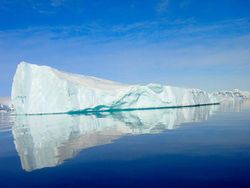برد
البرد Cold، هو حالة تنخفض فيها [[درجة الحرارة. الجسم البارد عكس الساخن، أو هو الجسم الذي تنخفض درجة حرارته.
يعتبر الصفر المطلق هو الحد الأدنى لدرجة الحرارة، ويعبر عنه بالرمز 0 ك في مقياس كلڤن، وكمقياس حرارة ترموديناميكية مطلق. ويكافئ −273.15 °س على المقياس السلسيوزي، −459.67 °ف على مقياس فهرنهايت, و0 °ر على مقياس رانكين.
وحيث أن درجة الحرارة ترتبط بالطاقة الحرارية التي تحملها بعض الأجسام، which is the kinetic energy of the random motion of the particle constituents of matter, an object will have less thermal energy when it is colder and more when it is hotter. If it were possible to cool a system to absolute zero, all motion of the particles in a sample of matter would cease and they would be at complete rest in this classical sense. The object would be described as having zero thermal energy. Microscopically in the description of quantum mechanics, however, matter still has zero-point energy even at absolute zero, because of the uncertainty principle.
في الثدييات
التبريد
أشهر المواقع والأجسام الباردة
- The coldest known temperature ever achieved is a state of matter called the Bose–Einstein condensate which was first theorized to existing by Satyendra Nath Bose in 1924 and first created by Eric Cornell, Carl Wieman, and co-workers at JILA on June 5, 1995. They did this by cooling a dilute vapor consisting of approximately two thousand rubidium-87 atoms to below 170 nK (one nK or nano K is a billionith (10^-9) of a degree Kelvin) using a combination of laser cooling (a technique that won its inventors Steven Chu, Claude Cohen-Tannoudji, and William D. Phillips the 1997 Nobel Prize in Physics) and magnetic evaporative cooling.
- The Boomerang Nebula is the coldest known natural location in the universe, with a temperature that is estimated at 1 K (kelvin) (−272.15 °C/−457.87 °F).[1]
- Herschel Space Observatory instruments and detectors are kept at temperatures below 2 K, using a large helium tank for cooling.[2]
- Absent any other source of heat, the temperature of the Universe roughly 2.725 kelvin, due to the Cosmic microwave background radiation, a remnant of the big bang.[3]
- Neptune's moon Triton has a surface temperature of −235 °C (−390 °F).
- Uranus with an atmospheric temperature of −215 °C (−355 °F).[4]
- Saturn with a temperature of −175 °C (−285 °F) at cloud tops.[5]
- Mercury, despite being close to the Sun, is actually cold during its night, with a temperature of about −170 °C (−275 °F). Mercury is cold during its night because it has no atmosphere to trap in heat from the Sun.[6]
- Jupiter with a temperature of −145 °C (−230 °F) at the cloud tops.[7]
- Mars has a temperature of about −125 °C (−195 °F).[8]
- The coldest continent on Earth is Antarctica.[9] The coldest place on Earth is the Antarctic Plateau,[10] an area of Antarctica around the South Pole that has an altitude of around 3,000 metres (9,800 ft). The lowest reliably measured temperature on Earth of −89.2 °C (−128.6 °F) was recorded there at Vostok Station on 21 July 1983[11] (See List of weather records).
انظر أيضاً
|
|
المصادر
- ^ "Boomerang Nebula boasts the coolest spot in the Universe". NASA's Jet Propulsion Laboratory. June 20, 1997. Retrieved July 8, 2009.
- ^ Jonathan Amos (9 February 2009). "'Silver Sensation' Seeks Cold Cosmos". BBC News. Retrieved 2009-03-06.
- ^ Hinshaw, Gary (December 15, 2005). "Tests of the Big Bang: The CMB". NASA WMAP. Retrieved 2007-01-09.
- ^ http://www.nasa.gov/worldbook/uranus_worldbook.html
- ^ http://www.nasa.gov/worldbook/saturn_worldbook.html
- ^ http://www.nasa.gov/worldbook/mercury_worldbook.html
- ^ http://www.nasa.gov/worldbook/jupiter_worldbook.html
- ^ http://www.nasa.gov/worldbook/mars_worldbook.html
- ^ http://earthobservatory.nasa.gov/IOTD/view.php?id=8070
- ^ Bignell, Paul (2007-01-21). "Polar explorers reach coldest place on Earth". The Independent. London. Retrieved 2010-04-30.
- ^ Budretsky, A.B. (1984). "New absolute minimum of air temperature". Bulletin of the Soviet Antarctic Expedition (in Russian). Leningrad: Gidrometeoizdat (105).
{{cite journal}}: CS1 maint: unrecognized language (link)
